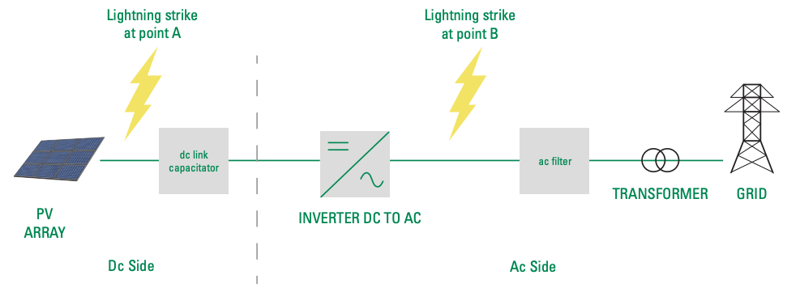Surge Protection Devices for Solar Applications
Lightning’s perfect storm for destruction is on the solar field. Solar panels’ large—and often exposed and isolated—location make surge protection critical for it to last its designated lifespan.
Lightning is an electrical discharge in the atmosphere. When lightning strikes, fires are prone to happen due to the release of energy. Nimbus (rain) clouds, have a concentration of electrical charge, and their accumulation creates an ionization of air. The ionization of air that is between the ground and the nimbus clouds creates a discharge from the clouds to the ground. Nimbus clouds cause the biggest surges because they are what generate lightning.
Indirect lightning strikes are destructive. Anecdotal observations about lightning activity is usually a poor indicator of the level of lightning-induced overvoltages in photovoltaic (PV) arrays. Indirect lightning strikes can easily damage the sensitive components within PV equipment, which often has a high cost to repair or replace the damaged components, and affects the PV system’s reliability.
Photovoltaic systems are exposed in large open spaces, typically in fields or on the tops of buildings. Charged rain clouds that accumulate over such open fields have the propensity to release the charge in the form of lightning. When this happens, a voltage surge is likely to occur. The more expansive the field is, the more likely destruction is to occur.
Electronic equipment can easily be damaged to the point of catastrophic failure by surges. If a surge occurs when any personnel are present, it will jeopardize their safety as well. Indirect lightning strikes can be fatal if the person is within 60 feet from the point of the lightning strike. When a PV system is located on an industrial site, the business operations and equipment are also at jeopardy. Inverters are expensive, but for industrial applications, an even more expensive failure is the cost of downtime and data loss.
When lightning strikes a solar PV system, it causes an induced transient current and voltage within the solar PV system wire loops. These transient currents and voltages will appear at the equipment terminals and likely cause insulation and dielectric failures within the solar PV electrical and electronics components such as the PV panels, the inverter, control and communications equipment, as well as devices in the building installation. The combiner box, the inverter, and the MPPT (maximum power point tracker) device have the highest points of failure.
To prevent high energy from passing through electronics and causing high voltage damage to the PV system, voltage surges must have a path to ground. To do this, all conductive surfaces should be directly grounded and all wiring that enters and exits the system (such as Ethernet cables and ac mains) be coupled to ground through a surge protection device (SPD).
An SPD is needed for each group of strings within the combiner box, the recombiner box, as well as the dc disconnect.
Surge Protection Device Selection for Solar Applications
Photovoltaic PV systems have unique characteristics, which therefore require the use of SPDs that are specifically designed for PV systems.
PV systems have high dc system voltages up to 1500 volts. Their maximum power point operates at only a few percentiles below the system’s short circuit current.
To determine the proper SPD module for the PV system and its installation, you must know:
- the lightning round flash density;
- the system’s operating temperature;
- the system’s voltage;
- the system’s short circuit current rating;
- the level of waveform that is to be protected against (indirect or direct lightning); and
- the nominal discharge current.
The SPD requirements for an installation that is protected by an external lightning protection system (LPS) depend on the selected class of the LPS and whether the separation distance between the LPS and the PV installation is isolated or non-isolated. IEC 62305-3 details the separation distance requirements for an external LPS.
To have a protective effect, an SPD’s voltage protection level (Up) should be 20 % lower than the dielectric strength of the system’s terminal equipment.
It is important to use an SPD with a short circuit withstand current greater than the short circuit current of the solar array string that the SPD is connected to. The SPD that is provided on the dc output must have a dc MCOV equal to or greater than the maximum photovoltaic system voltage of the panel.

Figure 1. Lightning strike location
When lightning strikes at point A (see Figure 1), the solar PV panel and the inverter are likely to be damaged. Only the inverter will be damaged if the lightning strikes at point B. However, the inverter is typically the most expensive component within a PV system, which is why it is essential to properly select and install the correct SPD on both the ac and dc lines. The closer the strike is to the inverter, the more damaged the inverter will be.
What You Will Get in This Guide
This paper provides technical and in-depth information on:
- Surge protection device classifications
- The installation of SPDs for the dc side and the ac side of photovoltaic systems
- Cable considerations for SPD selection and installation in photovoltaic systems
- How to combine SPDs with inverters
- Codes and standards related to surge protection in solar applications
Gain access to the complete guide by filling out the form.
